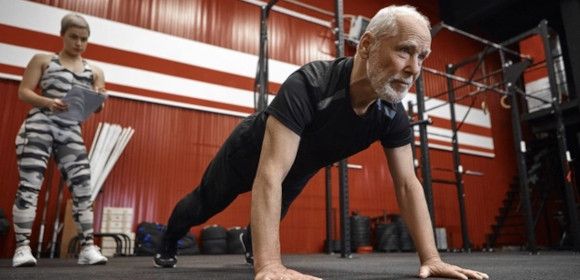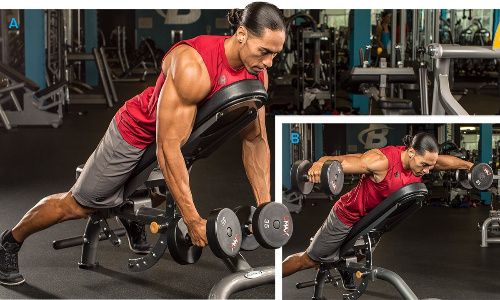How to Maintain Intense Training After 50
Aug-18-2024
A few of our top experts share their best advice on maintaining strength as you age.
We all know that staying in shape becomes more challenging as the years go by. But with more men in their 50s hitting the gym and others in their 50s and 60s looking as fit as ever, it's clear: You can stay in shape even as you age.
Older men continue to chase muscle. Just look at MH cover star Lenny Kravitz, who’s 56 with abs that break the internet, or Hugh Jackman, still deadlifting like Wolverine. And Jason Statham? He’s 53 and still kicking ass.
Your muscle-building journey doesn’t have to end at 50. We’ve found the seasoned trainers who can show you how to keep going strong. Maybe you’re no longer aiming for extreme hypertrophy, but that doesn’t mean you’re relegated to dance workouts and speed-walking. “You don’t have to change everything you’re doing,” says 47-year-old former bodybuilder Bryan Krahn, C.S.C.S., author of Men’s Health Muscle After 40. “Just work smarter.” Here’s how.
Shift Your Mindset

Older men are still chasing muscle gains. Just look at Lenny Kravitz, a Men's Health cover star at 56, flaunting abs that dominate Instagram. Or Hugh Jackman, still deadlifting like Wolverine, and Jason Statham, who at 53, continues to kick serious ass.
Your quest for muscle doesn’t have to end at 50. We've connected with top trainers for senior athletes who can guide you on this journey. While you might not push through hypertrophy extremes anymore, you’re far from resorting to dance-aerobics or speed-walking. "You don't have to overhaul everything," says 47-year-old former bodybuilder Bryan Krahn, C.S.C.S., author of Men's Health Muscle After 40. "Just train smarter." Here's how.
Dumbbells Are Your Friends
Dumbbell lifting has long been a gym staple, offering a solid foundation for strength training. However, it can restrict your range of motion, especially as you get older. With age, your connective tissues lose flexibility, so consider swapping traditional barbell presses for dumbbell presses to maintain better joint mobility.
Embrace Bodybuilding Moves
Full-body exercises like cleans and squats are essential in CrossFit, but don’t overlook bodybuilding-style isolation exercises like bicep curls. These moves allow for quicker recovery than heavy lifts, enabling you to train more frequently. Incorporate them into your routine twice a week for balanced development.
Prioritize Recovery After Intense Workouts

Your body can recover from intense workouts with just a bit of extra care. Focus on doubling your recovery time. Coach Bobby Maximus, 42, author of Maximus Body, emphasizes the importance of recovery just as much as hitting the gym. For every 30 minutes spent exercising, dedicate an hour to foam rolling or gentle yoga.
Set Limits on Your Training
Pushing through an extra minute of burpees today isn't worth compromising tomorrow's workout. "Your work capacity starts to decline, along with your ability to recover," says Krahn. To prevent burnout, limit your sessions to a set duration (like 45 minutes) or a specific number of sets (12 working sets, and no more).
Understand the Greatest Threat to Staying Fit The biggest threat to your fitness comes from within: sarcopenia, the age-related loss of skeletal muscle mass. This condition can reduce muscle mass by 3% to 8% every decade starting in your 30s. But there's a way to fight back.
Identify the Real Enemy
You can't combat sarcopenia by simply lifting weights to build strength, says Brad Schoenfeld, Ph.D., a veteran muscle researcher. You need to develop a specific type of strength: power.
Traditional strength is your ability to lift, say, 20 pounds. Power, however, is your ability to lift that weight quickly. Incorporate power training into your workouts twice a week, using lighter weights. Perform 3 sets of 6 reps, taking 2 seconds to lower the weight and 1 second to lift it explosively.
Eat to Build Muscle

Your hamstrings play a crucial role in stabilizing your body during various movements. To target them effectively, lie on your back with your heels on a bench, toes pointing towards the ceiling, and knees slightly bent. Engage your core, press your heels into the bench, and lift your hips as high as possible until they align with your knees and shoulders. Hold this position for 20 to 30 seconds, squeezing your hamstrings. That's 1 rep; perform 5 reps.
Pallof Press
This exercise is your go-to for combating lower back pain. Attach a resistance band to a post just below shoulder height. Grasp the band with both hands, keeping your arms close to your chest. Turn so your left shoulder faces the anchor point, then step away until the band is taut. This is your starting position. Tighten your core and extend your arms straight in front of you; hold for 2 seconds. Return to the starting position. That's 1 rep; complete 3 sets of 12 to 15 reps on each side.
Resistance Band Pull-Apart

Building mid-back strength is essential for long-term shoulder health. Stand holding a light resistance band with both hands, arms extended in front of you, core tight, and palms facing each other. With a slight bend in your elbows, keep your arms parallel to the ground as you pull the band apart, squeezing your shoulder blades together. Pause, then return to the start. That's 1 rep; perform 3 sets of 15 reps.
Optimize Your Movements
NEWSFLASH: Your body doesn’t care about flashy Instagram-worthy exercises, and neither do your friends. Build muscle and stay strong by focusing on safe, effective movements—and by refining some of the riskier ones.
3 Moves to Love
Not everyone has the hip mobility to deadlift from the floor. Romanian deadlifts offer a safer alternative. Start by standing with a weight at your hips, then slowly lower your torso while pushing your hips back.
3 Moves to Modify

Box Jumps
Box jumps enhance lower-body explosiveness, but to avoid injury, set the box height 10 inches lower than your maximum jump.
Wide-Grip Pullup
Opt for neutral-grip pullups instead, with your hands slightly wider than shoulder-width. This helps protect your shoulders from long-term injury.
Barbell and Dumbbell Military Press
Many lifters lack the shoulder mobility needed for overhead presses. Instead, choose landmine presses, which allow your arms to move slightly in front of your torso, reducing strain on your shoulders.